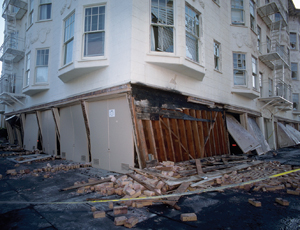These are scary times, and for those citizens living in earthquake country, the times are not just scary, they are terrifying. For starters, a major earthquake is overdue along the Hayward Fault, in the East Bay area near San Francisco: It could happen at any moment. San Francisco has 120,000 buildings, at least 90% of them erected before the adoption of modern building codes in the 1970s. Most won’t flat-out collapse in a city-centered earthquake the size of 1989’s Loma Prieta, but there will be damage beyond repair from the quake and ensuing fire to about a quarter of the buildings, say San Francisco planners.

Yet the area’s earthquake-preparedness community says pleas for action to mitigate the impact of such a disaster fall on deaf ears in Sacramento and in City Hall because earthquakes are not the disaster of the day, but rather terrorism and the Great Recession. Nevertheless, a group of determined planners has initiated a campaign in San Francisco that could transform the paradigm for earthquake preparedness, impact and recovery.
The campaign spurred by the nonprofit San Francisco Planning and Urban Research (SPUR) Association is called “Resilient City,” and it can serve as a model for community planning everywhere. In a so-called resilient city, the standard engineering for life safety is not enough; the goal is building to repair, not just building to protect. “Our current building code is good enough if you are trying to prevent deaths, but it is nowhere near good enough if you are trying to rebuild a city quickly after an earthquake,” says SPUR Deputy Director Sarah Karlinsky.
SPUR has a big problem: Its critical mission is largely being ignored. It needs funding to craft a mitigation program and refine response and rebuilding plans, government support to create financial incentives for retrofits and new building codes that move beyond life-safety minimums and wasteful demolition toward designing and building repairable structures through performance-based engineering. The effort is a matter of public health, safety and economics. “When we choose our engineering standards, we are really choosing to define how many deaths, how many building demolitions and how long a recovery time we will have for various levels of earthquakes,” says Karlinsky.
Some seismic retrofits are relatively easy and cost-effective, especially at ground level, while others are not. SPUR says it could take 50 years to transform San Francisco into a resilient city, where buildings and infrastructure are designed to be repaired based on a predetermined list of priorities. This is not an outlandish objective, and there is no time like the present to begin.

Post a comment to this article
Report Abusive Comment